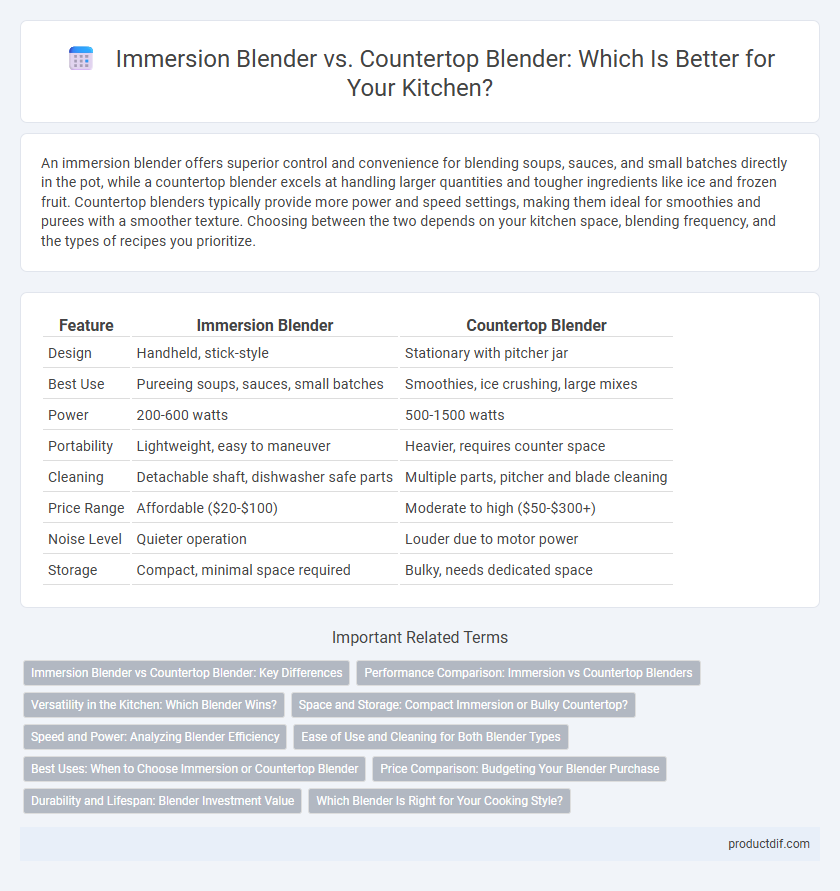An immersion blender offers superior control and convenience for blending soups, sauces, and small batches directly in the pot, while a countertop blender excels at handling larger quantities and tougher ingredients like ice and frozen fruit. Countertop blenders typically provide more power and speed settings, making them ideal for smoothies and purees with a smoother texture. Choosing between the two depends on your kitchen space, blending frequency, and the types of recipes you prioritize.
Table of Comparison
| Feature | Immersion Blender | Countertop Blender |
|---|---|---|
| Design | Handheld, stick-style | Stationary with pitcher jar |
| Best Use | Pureeing soups, sauces, small batches | Smoothies, ice crushing, large mixes |
| Power | 200-600 watts | 500-1500 watts |
| Portability | Lightweight, easy to maneuver | Heavier, requires counter space |
| Cleaning | Detachable shaft, dishwasher safe parts | Multiple parts, pitcher and blade cleaning |
| Price Range | Affordable ($20-$100) | Moderate to high ($50-$300+) |
| Noise Level | Quieter operation | Louder due to motor power |
| Storage | Compact, minimal space required | Bulky, needs dedicated space |
Immersion Blender vs Countertop Blender: Key Differences
Immersion blenders offer handheld convenience for blending directly in pots, bowls, or pitchers, making them ideal for quick purees and soups, while countertop blenders provide powerful motors and larger capacities suited for heavy-duty tasks like crushing ice and making smoothies. The size and portability of immersion blenders allow for easy storage and minimal cleanup, whereas countertop blenders typically come with multiple speed settings and pulse functions for versatile blending control. Choosing between the two depends on the kitchen tasks, with immersion blenders excelling in simplicity and space-saving, while countertop models deliver superior power and consistent texture.
Performance Comparison: Immersion vs Countertop Blenders
Immersion blenders offer precise control and are ideal for blending directly in pots or containers, providing convenience for purees and soups with minimal cleanup. Countertop blenders deliver more powerful motors and larger capacities, excelling at crushing ice, making smoothies, and handling tough ingredients with consistent texture. Performance varies as immersion blenders prioritize portability and ease, while countertop blenders focus on power and versatility for complex blending tasks.
Versatility in the Kitchen: Which Blender Wins?
Immersion blenders excel in versatility by easily blending soups, sauces, and smoothies directly in pots or bowls, offering precise control and easy cleanup; countertop blenders provide powerful motors and larger capacity, ideal for crushing ice, making large batches, and ensuring consistent texture. For small, quick tasks and hands-on blending, immersion blenders are preferred, while countertop blenders suit meal prep requiring more power and volume. Choosing between them depends on kitchen needs--immersion blenders enhance everyday convenience, whereas countertop blenders deliver robust performance for diverse blending challenges.
Space and Storage: Compact Immersion or Bulky Countertop?
Immersion blenders offer a highly compact design that fits easily into kitchen drawers or small storage spaces, making them ideal for kitchens with limited countertop area. Countertop blenders typically require dedicated counter space and come with bulky bases that can be challenging to store when not in use. Choosing an immersion blender maximizes kitchen efficiency by reducing clutter and providing convenient, accessible food preparation tools.
Speed and Power: Analyzing Blender Efficiency
Immersion blenders typically offer faster, more precise blending for small batches due to their handheld design and motor power ranging from 200 to 300 watts. Countertop blenders, equipped with motors between 500 and 1500 watts, provide higher power and efficiency for larger quantities and tougher ingredients like ice or frozen fruits. Evaluating speed and power reveals countertop blenders excel in heavy-duty blending tasks, while immersion blenders prioritize quick, convenient blending for soups and sauces.
Ease of Use and Cleaning for Both Blender Types
Immersion blenders offer superior ease of use due to their lightweight design and handheld functionality, allowing for direct blending in pots or bowls without transferring contents. Cleaning an immersion blender is typically quicker since the detachable blending shaft is dishwasher-safe or easily rinsed under running water. Countertop blenders, while powerful, require disassembly of the pitcher and blade assembly for cleaning, which can be more time-consuming and less convenient compared to immersion models.
Best Uses: When to Choose Immersion or Countertop Blender
Immersion blenders are best for blending soups, sauces, and smoothies directly in the pot or container, offering convenience and easy cleanup for small to medium batches. Countertop blenders excel at handling larger quantities, crushing ice, and making thicker mixtures like nut butters or frozen drinks with powerful motors and durable blades. Choosing between the two depends on the quantity, texture, and type of ingredients you frequently prepare in your kitchen.
Price Comparison: Budgeting Your Blender Purchase
Immersion blenders typically range from $20 to $70, making them a budget-friendly choice for everyday blending tasks and small batches. Countertop blenders, with prices spanning from $50 to over $300, offer more power and versatility but require a higher initial investment. Evaluating your kitchen needs and blending frequency helps determine the best value within your price range.
Durability and Lifespan: Blender Investment Value
Immersion blenders typically offer longer lifespan and enhanced durability due to their simpler design and fewer moving parts compared to countertop blenders. Countertop blenders, while powerful and versatile, often have motors and blades that wear out faster with heavy use, impacting their overall investment value. Choosing an immersion blender can lead to better long-term performance and reduced replacement costs in busy kitchen environments.
Which Blender Is Right for Your Cooking Style?
Immersion blenders offer precise control and are ideal for blending soups, sauces, and small batches directly in the pot, while countertop blenders excel at handling larger quantities and tougher ingredients like ice and frozen fruits. Consider an immersion blender for quick, simple tasks and easy cleanup, or choose a countertop blender for versatility in smoothies, purees, and crushing ice. The right blender depends on cooking volume, texture preference, and ease of use in your kitchen routine.
Immersion Blender vs Countertop Blender Infographic

 productdif.com
productdif.com